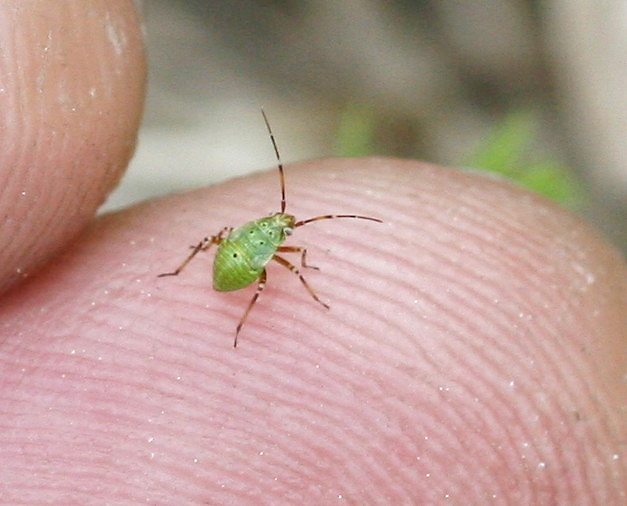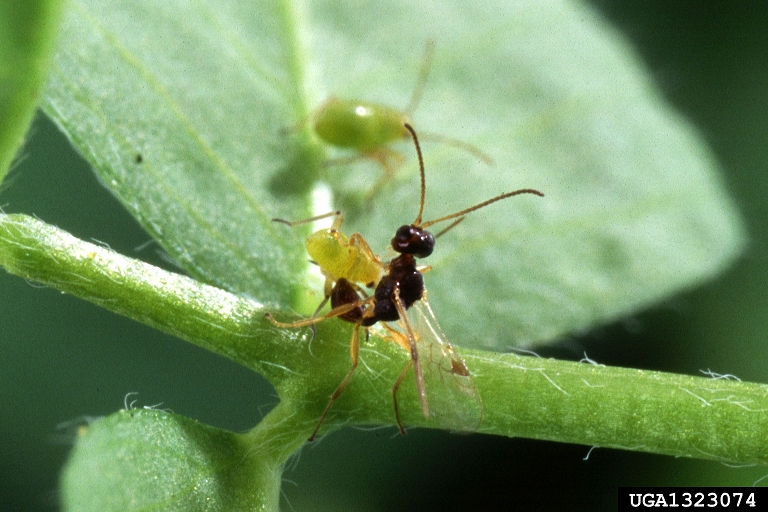Among the several species of plant bugs that invade New Hampshire fruit, vegetable, and ornamental crops, the one that does the most damage is the tarnished plant bug (TPB), Lygus lineolaris. This pest is a threat to strawberries and will also damage peaches, pears, raspberries, apples, and grapes, as well as beans, beets, cabbage, cauliflower, celery, cucumbers, potatoes, turnips, and many ornamentals. TPB can cause several types of injury: scarred or dwarfed fruits, catfacing, aborted fruit buds, and dwarfed or misshapen plants.
A European TPB parasite was established in New Hampshire in the 1980’s. Since then, TPB injury to tree fruits has been reduced significantly.
Description
TPB is a small, greenish-brown, flattened insect approximately ¼ inch long, with piercing-sucking mouth-parts. It has a diamond shaped area on the back caused by the overlapping of the wing covers. The immature stage (nymph) is a yellowish-green oval insect, taking on a similar shape as the adult after five molts. Older nymphs have four round black dots on the back and one on the abdomen. TPB eggs are cream-colored and flask-shaped, with a flattened edge. They are laid in plant tissue so that only the small anterior end is visible.

Life Cycle and Damage
TPB overwinters as an adult under bark, garden debris, and among clover, alfalfa, and mullein leaves. The overwintering adult becomes active very early in the spring, attacking the buds of early developing fruits. This can kill buds or show up as scars on the fruits. On apples, it often appears as a round scab, often within a dimple. On strawberries, damaged fruits have a hard, greenish, seedy area at the tip. Damaged raspberries are uneven and misshapen.
TPB lays its eggs primarily on weeds, grasses, and vegetables. The eggs hatch in about 10 days. It takes 3-4 weeks for the nymphs (immatures) to develop to the adult stage, during which time they may feed like adults and cause similar damage to crops. There are typically two generations of TPB per year in New Hampshire.
Management
IPM Strategies:
Cultural Practices and Non-Chemical Controls
There are a number of cultural practices available to keep TPB numbers in check:
- Weed Management - Control weeds and fall plant debris in and around gardens and orchards to reduce TPB egg laying and overwintering sites.
- Floating Row Covers - Floating row covers placed over low-growing plants in vegetable gardens provide a physical barrier protecting plants against TPB. When the crop’s flowers appear, floating row covers must be removed to admit pollinating insects.
- Survey and Detection - From mid-April to early May, examine plants for bleeding wounds, brown discolored tissues, and other malformations. Also, look for adult TPBs on fruits, flowers, and foliage of susceptible crops.
- Monitor Devices - Use commercial, non-ultraviolet-reflecting white sticky boards to monitor for adults in spring.
- Crop Placement - Avoid planting susceptible crops, such as strawberries, close to clover or alfalfa crops.
Biological Practices
In the 1980’s a TPB parasite was introduced into New Hampshire to improve the biological control of TPB. This parasite is now established in New Hampshire, but it does not completely control the pest, and TPB can still seriously damage strawberries.

Chemical Control
Hundreds of pesticides are registered in New Hampshire for control of TPB. Many of the pesticides formulated for backyard use have been diluted so that they are not very effective on this insect. Because of the growing presence of the TPB parasites, experts recommend being cautious when spraying for this pest.
For specific chemical controls, see the current New England Small Fruit Management Guide, New England Tree Fruit Management Guide, New England Vegetable Management Guide, or contact your local county Agriculture Extension Field Specialist.
Stop! Read the label on every pesticide container each time before using the material. Pesticides must be applied only as directed on the label to be in compliance with the law. All pesticides listed in this publication are contingent upon continued registration. Contact the Division of Pesticide Control at (603) 271-3550 to check registration status. Dispose of empty containers safely, according to New Hampshire regulations.
Download the resource for the complete factsheet.

